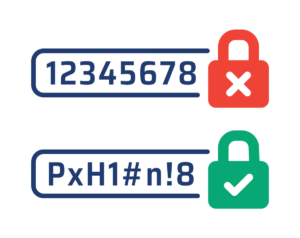Best Practices to Protect Your Data from Hackers: As cyber threats grow more sophisticated, protecting sensitive data—especially in the fintech sector—is more critical than ever.
Hackers continuously exploit vulnerabilities, targeting individuals, businesses, and financial institutions.
Also Read: How to Stay Anonymous Online in 2025
From phishing attacks to ransomware threats, a single breach can result in financial losses, identity theft, and reputational damage.
In this guide, we’ll explore the best practices to protect your data from hackers, ensuring strong cybersecurity measures for both individuals and fintech professionals.
Key Benefits of Best Practices to Protect Your Data from Hackers

Implementing robust cybersecurity measures offers multiple benefits:
✅ Prevents Financial Fraud – Protects your bank accounts and fintech transactions from unauthorized access.
✅ Safeguards Personal Information – Avoids identity theft and data leaks.
✅ Enhances Business Security – Strengthens fintech platforms and payment systems against cyberattacks.
✅ Reduces Phishing & Malware Risks – Stops malicious actors from infiltrating your network.
✅ Ensures Regulatory Compliance – Meets cybersecurity laws like GDPR, CCPA, and PCI DSS for financial transactions.
Did you know? In 2024 alone, cybercrime cost the global economy over $8 trillion (Cybersecurity Ventures).
Challenges & Considerations in Data Protection

Even with the best security practices, challenges persist.
1. Evolving Cyber Threats
Hackers constantly develop new attack methods, including:
- AI-driven cyberattacks that automate hacking attempts.
- Deepfake scams used to bypass identity verification.
- Ransomware-as-a-Service (RaaS) making attacks more accessible.
2. Human Error & Weak Passwords
- Over 80% of data breaches occur due to weak passwords (Verizon Data Breach Report 2024).
- Many users reuse passwords, increasing their risk of cyberattacks.
3. Regulatory & Compliance Issues
- FinTech companies must follow strict data protection regulations (GDPR, PCI DSS, CCPA).
- Failure to comply can result in heavy fines and loss of user trust.
Best Practices to Protect Your Data from Hackers

1. Use Strong, Unique Passwords & Enable Multi-Factor Authentication (MFA)

- Create passwords with at least 12–16 characters (mixing letters, numbers, and symbols).
- Use a password manager like Bitwarden or LastPass to store credentials securely.
- Enable Multi-Factor Authentication (MFA) to add an extra security layer.
Example: A strong password:
G!9b@t#Y72_xK$Lis harder to crack thanJohn1234.
2. Keep Software & Systems Updated

- Regularly update operating systems, fintech apps, and security software.
- Enable automatic updates to patch vulnerabilities in real time.
- Use antivirus software (Bitdefender, Norton, or Kaspersky) for added protection.
Fact: 58% of data breaches occur due to unpatched software (Ponemon Institute).
3. Encrypt Your Data & Use Secure Networks

- Use end-to-end encryption (E2EE) for emails, fintech transactions, and messaging apps.
- Avoid public Wi-Fi; use a VPN (Virtual Private Network) for secure browsing.
- Store sensitive fintech data on encrypted drives or cloud services (e.g., ProtonDrive).
Tip: Encrypt your emails with ProtonMail or Tutanota to prevent data interception.
4. Be Aware of Phishing Scams & Social Engineering Attacks

- Never click on suspicious links in emails, messages, or fintech platforms.
- Verify sender identities before sharing personal or financial information.
- Use AI-powered email filters (Google’s AI Shield, Barracuda) to detect phishing attempts.
Example: A phishing email may look like it’s from “PayPal Support” but has a misspelled domain like
paypall.com.
5. Secure Your FinTech Transactions

For fintech users, financial security is a top priority:
- Use decentralized wallets (Ledger, Trezor) for crypto storage.
- Prefer privacy-focused payment solutions like Monero (XMR) or Zcash (ZEC).
- Enable biometric authentication for secure fintech app access.
Fintech Trend: More users are shifting to decentralized finance (DeFi) to reduce exposure to traditional banking risks.
How Cybersecurity Affects the FinTech Industry & Consumers

1. Increasing Cybersecurity Investments in FinTech

Invest in Cybersecurity | Best 17 Signs You Need to Invest in Cybersecurity
- FinTech companies invest over $20 billion annually in cybersecurity solutions (Statista 2025).
- Blockchain-based security is emerging as a key fintech defense mechanism.
2. User Trust & Regulatory Compliance

- Consumers demand higher security measures from fintech platforms.
- Regulations like PSD2 (Payment Services Directive 2) and GDPR require stringent data protection.
Industry Impact: FinTech startups integrating AI-driven fraud detection gain a competitive edge.
Expert Opinions & Market Trends

📈 Cybersecurity Market Growth
Cyber Security Market Size, Share, Trends | CAGR of 12%
- The global cybersecurity market is expected to reach $250 billion by 2026.
- AI-driven security solutions are rapidly expanding in fintech.
🔍 Rise of Zero Trust Security
- Experts recommend Zero Trust Architecture (ZTA) for fintech firms.
- This means no user or device is trusted by default, reducing insider threats.
Key Insight: Companies using Zero Trust models reduce breach risks by 50% (Gartner Report 2025).
FAQs
1. What’s the easiest way to protect personal data from hackers?
Use strong passwords, MFA, VPNs, and encryption tools to prevent unauthorized access.
2. Can financial transactions be made completely secure?
While no system is 100% hack-proof, using end-to-end encryption, private wallets, and decentralized finance (DeFi) platforms enhances security.
3. How often should I update my cybersecurity measures?
Regularly! Enable automatic software updates, change passwords every 3–6 months, and monitor cybersecurity trends.
Final Thoughts On Best Practices to Protect Your Data from Hackers
As cyber threats evolve, taking proactive security measures is crucial for fintech professionals and everyday users alike. From strong passwords and encryption to AI-driven fraud detection, cybersecurity in 2025 demands continuous vigilance.
💡 Want to learn more about fintech security?
Check out our guides on How to Stay Anonymous Online in 2025.
🔐 How do you protect your data from hackers? Share your thoughts in the comments below!

